Blemish Removal
But don’t worry, I have just the thing! I can zap them away, quickly and easily with my nifty little machine.
You might be noticing little thread veins around your nose or on your cheeks – which make you look redder than you are or maybe you just don’t like them.
Similarly you might notice little red blood spots here and there.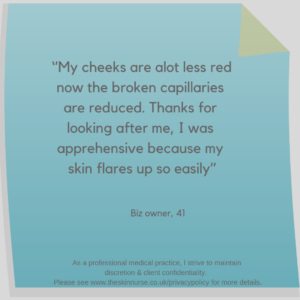
Maybe you’re prone to skin tags, and unfortunately with age, they no longer like to show up alone, but sometimes in groups!
Or maybe you have a cluster of Milia (those stubborn solid white bumps) on your cheeks or near your eyes?
These are all harmless, but some will get bigger, meaning they’ll be even harder to cover up.
If they bother you, I can help and here’s how…
Very simply – the blood supply is cauterised, which for broken capillaries makes them invisible on the surface of the skin, and with skin tags they no longer have the blood supply so cannot survive. The results are often immediate, although you will have to skip the makeup for a day or so…
If you’d like to see if you’re suitable for blemish removal treatment, book yourself in for a consultation at the bottom of this page.
What can be treated?
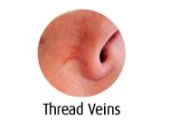
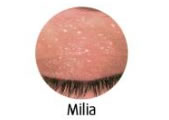
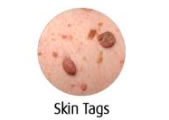
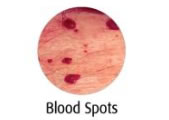
Broken Capillaries (Telangiectasia) Blemish Removal
What are broken capillaries?
Telangiectasia, or more commonly known as thread veins, broken/dilated capillaries, spider veins, spider naevi or dermal flare…are a common issue for approximately 50% of the population. These are very fine veins (capillaries) that can be seen just under the surface of the skin as tiny red lines.
What causes telangiectasia?
There are many causes. It could be one or a combination of the following:
The ageing process; sun-damage; pregnancy; trauma; smoking; high impact sports/exercise; friction; alcohol; fragile/thin skin; extreme weathers, it can also be hereditary.
How are these veins treated?
Following appropriate cleansing, the tip of a fine probe (width similar to that of a hair) is introduced along the line of the capillary and a high-frequency energy is discharged. This energy ‘dries-up’ the dilated vessel and then it disappears, as if by magic!
What areas of the body can be treated?
The décolletage and face area can be treated. This treatment is suitable for thread veins on the face and chest area. It is not effective on the legs and is unsuitable for a bearded area if shaving is required.
Milia Blemish Removal
What is milia?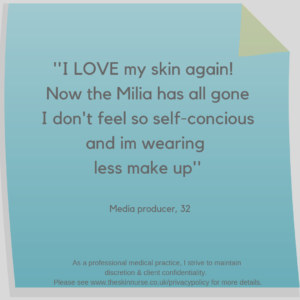
Milia are pearly white papules (hard white spots) often found on the cheeks, nose and around the eyes. They are superficial cysts under the skin filled with keratinaceous debris. They are not harmful, however people often find them unsightly and frustrating!
What causes milia?
Milia can be caused by many things. They are often visible on dry/dehydrated skin, and skins where very rich creams are used regularly. Milia can be caused by diet and when extreme cases are seen it is usually advised to get your cholesterol levels checked with your GP.
Skin Tags Blemish Removal
What are skin tags?
Skin tags are benign, skin growth’s commonly found on the eyelids, neck, chest, under the breasts, armpit, or groin areas. Skin tags are harmless small flaps of skin and don’t usually cause pain or discomfort. You may want to consider getting them removed if they are unsightly and affect your self-esteem, or if they snag on clothing or jewellery and bleed.
Skin tags (acrochordons) are small flesh-coloured or brown growths that hang off the skin and look a bit like loose warts. They’re very common and harmless.
Skin tags can vary in size from a few millimetres up to 5cm wide.
What causes skin tags?
Anyone can develop skin tags, but they’re particularly common in older people and people with diabetes. Pregnant women may be more likely to develop skin tags, caused by changes in their hormone levels. Some people develop them for no apparent reason. Skin tags tend to grow where skin rubs against skin or clothing. This would explain why they also tend to affect overweight people who have excess folds of skin and skin chafing.
Blood Spots Blemish Removal
What are blood spots?
Blood spots, otherwise known as Campbell de Morgan, are dome-shaped, shiny vascular blemishes, commonly found on the trunk.
What causes blood spots?
These are often genetic but have similar causes to broken capillaries: The ageing process; sun-damage; pregnancy; trauma; smoking; high impact sports/exercise; friction; alcohol; fragile/thin skin; extreme weathers.
FAQ’s
How does the treatment work?
A tiny needle tip is applied to the area. Heat is sent through the needle (a pin-prick will be felt). This heat cauterizes the vessel/blood supply, which makes the blemish disappear. The results are often immediate.
Will it hurt?
Everyone has a different pain threshold and there are various factors that can make you more sensitive from one day to the next, for example stress, hormones and your general health. This treatment is not pain-free, but it is very quick. The discomfort is often described as a sharp sting or like being flicked with an elastic band. Most people are motivated by the results that will be achieved and can bare some discomfort for the short amount of time that the treatment takes. You are likely to have some redness after the treatment.
How will my skin look afterwards?
Immediately after the treatment your skin might be red and it may feel warm and itchy too. Tiny crusts might appear anytime between two days and two weeks afterwards.
How long will the procedure take?
This depends mostly on the severity of the blemish on your skin. Your initial appointment will be a 15-30 minute consultation, which will include a patch test to gauge how your skin responds to the treatment (your sensitivity will impact the recovery). This will give us a good indication of how many treatments you will need to get the effect you desire.
Can anyone have this procedure?
This procedure is suitable for almost everyone, however like any treatment or procedure there are some health conditions that make this treatment contraindicated, this will be fully discussed during your consultation.
How long will the results last?
These blemishes can be removed permanently however, if the ‘cause’ is still part of your life-style, they may, in time, return. Effective results can be seen in minutes in some cases; however the final results depends on the severity of the condition and is personal to everyone. At your consultation a more specific time frame will be given to you.
Is this procedure safe?
Electrolysis has been around and in use for a long time and continues to be used as a safe treatment for a variety of indications. It has been used as a form of hair removal since the late 1800’s, and more specifically was first documented as being effectively used to treat spider naevi in 1875.
How much does it cost?
This procedure is charged by the length of your appointment, ie 15 or 30 minutes.
Your initial appointment which includes a Consultation and required Patch test, £50
Further appointments:
- 15 minutes £75
- 30 minutes £140
Blemish Removal After-care
Following your procedure it is vital for you to follow the advice given to you, to ensure your skin heals properly and to avoid any infection. You will always be given after-care advice both verbally and in writing during your appointment.
Your skin will feel warm and look hot. You may have some swelling and itching. You are likely to get some small areas of crusting in the treated areas too. These are all normal and expected.
In most cases for 24-48 hours after your treatment you must:
- Avoid touching the treated area
- Take care not to scratch or knock off any scabs/crusts that have formed
- Apply an after-care product such as Aloe Vera
- Clean/wash gently and PAT (do not rub) dry
Things to avoid:
- Your ’cause’ if known
- Flying
- Any heat treatments
- Swimming
- Perfume and perfumed products
- Sweating
- Exercise/extreme sports
